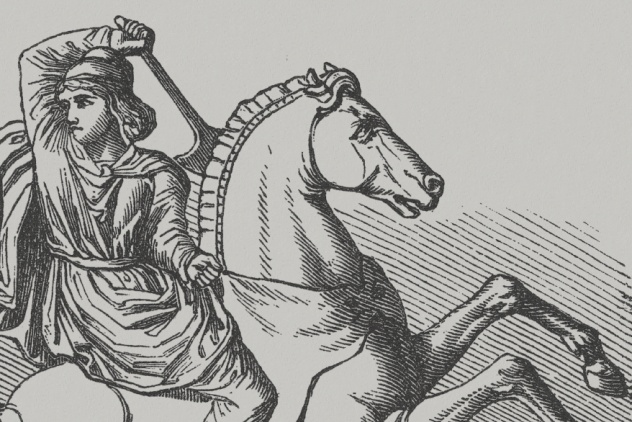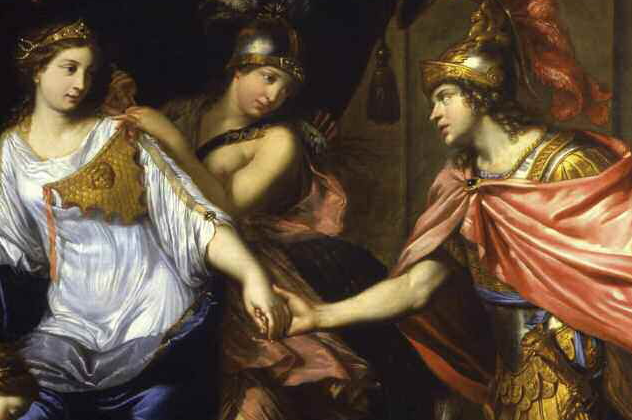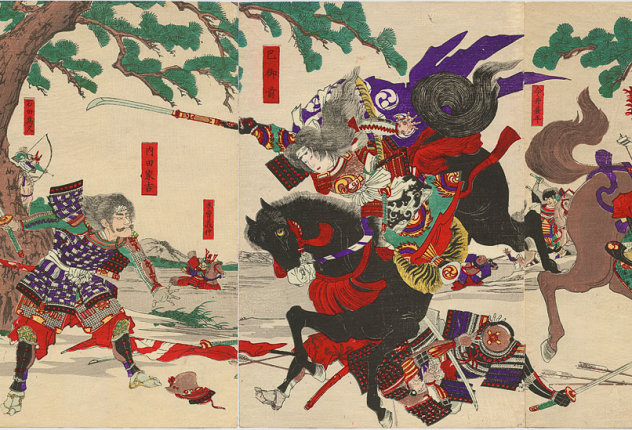10 The Origin Of The Name
9 Figment Of Greek Imagination?
Bachofen influenced artists such as Richard Wagner, whose Ring Cycle extols Brunnhilde and the Valkyries, and thinkers such as Friedrich Engels. Engels and his fellow Marxists envisioned the primeval rule of women as a peaceful, classless utopia where property didn’t exist. Engels lamented, “The overthrow of mother-right was the world historical defeat of the female sex. The man took command in the home also; the woman was degraded and reduced to servitude; she became the slave of his lust and a mere instrument for the production of children.” These notions were difficult to either corroborate or refute. But in the late 1980s, archaeological digs provided the first clues that the Greeks may have been relating history after all.
8 Evidence From Archaeology
Later scholars took Herodotus’s account with a grain of salt, until archaeological expeditions began to uncover graves of women with weapons and battle scars. Intriguingly, DNA evidence has indicated that 20–30 percent of burials in the steppes around the Black Sea were of warrior women. The items discovered in the women’s graves included armor, bronze arrowheads, daggers, swords, and horse harnesses—things not normally associated with women. The artifacts showed signs of being used, ruling out a mere symbolic or ritualistic motive for their inclusion. They weren’t hunting tools, either; these tribes were cattle-breeders, not hunters. The shorter handles of the weapons show that they were actually made for and used by women, who generally have smaller physiques. Remnants of skin also yielded war tattoos, substantiating Herodotus’s claim that the warriors made a special tattoo to record their kills. The bowed leg bones of one girl were a clue to her life on horseback. An arrowhead in the body cavity of another woman pointed to death in battle. While many similar burial sites lay far to the west, too remote for contact with the ancient Greeks, archaeologists have proven that tribes of fierce female warriors were more common on the Eurasian plain than was previously thought.
7 The Lesbian Myth
6 Beauty Secrets
Herodotus described a Scythian sauna: Bathing was a very important purification ritual for the tribe as it prepared for funerals in the spring. First, the Scythians washed their heads with soap and water. Then, they entered a tepee-like booth constructed of stakes and woolen felt. Inside, they tossed cannabis seeds onto red-hot stones, and the resulting steam cleansed their bodies, in addition to getting them high. In support of Herodotus was a Scythian burial mound discovered in the Caucasus in 2013. The site yielded gold vessels with the residue of opium and cannabis. Archaeologists think that the opium was drunk as part of a concoction while the cannabis smoke wafted nearby. Scythian graves also revealed what the women used for makeup. Boxes have been unearthed containing colorants such as ochre, cinnabar, black carbon, and white chalk. One cosmetics bag was accompanied by a horsehair face brush, a bronze mirror, and a piece of eyeliner pen filled with deep blue-green powder.
5 Alexander And Thalestris
4 Warrior Queens Of The Middle East
Warrior women were not confined to the Eurasian plains. Elsewhere in the ancient world, we find accounts similar to the Greek narratives. Neo-Assyrian records from the eighth century BC speak of queens of Qedar who ruled over nomadic Arab and Semitic tribes ranging from Syria to the Nile. One of them, Zabibi, may have been part of a dynasty that included the legendary Queen of Sheba, whose visit to King Solomon is recorded in the Bible. In a world where kings held absolute sway over governance, the mention of queens taking on a male-dominated role is intriguing. It lends credence to the Biblical tale of the Queen of Sheba. Sheba herself may be the “Saba,” whose tributes Tiglath Pileser received. However, after Queen Te’elkhunu in 691 BC, politically active Arab queens disappear from the historical record. By the first century AD, the Qedarites were no more, but the third century saw the rise of a warrior queen named Zenobia, who defied the Romans. Later medieval Arabic romances were populated by warlike females, among them a woman named “Wolf.”
3 The Elephants Of Samos
Elephants are not native to the Greek isle of Samos, so we can imagine how ancient Greeks were baffled by the skeletal remains of what appeared to be gigantic pachyderms in its soil. The mystery was debated and recorded by Plutarch around AD 100 in his Greek Questions, a compendium of ancient curiosities and marvels. The latter explanation came close to the truth. The fossils in Samos were actually prehistoric mastodons. The fossil beds were first investigated by scientists in 1870. They have since concluded that Miocene mastodons roamed the area eight million years ago.
2 Female Gladiators
There is also evidence that the Romans were witnesses to the fighting skills of actual women warriors. A 2,000-year-old bronze statuette of a female gladiator in the Museum of Art and Industry in Hamburg, only the second one known, tells us that women participated in deadly combat in the arena. The image is that of a woman, breasts exposed and wearing only a loincloth, her left hand holding a sica (a short, curved sword) in what appears to be a victory pose. Her use of the sica identifies her as a thraex, a gladiator who sported a plumed helmet, small shield, and metal leg guards. After a battle, gladiators removed their helmets and dropped their shields, explaining why the woman doesn’t have either of these items. Another notable discovery was that of a female gladiator’s tomb in London. The presence of expensive oil lamps and evidence of a large banquet indicates that this woman was a revered fighter—no small accomplishment in a society where women were not regarded as equals of men.
1 Female Samurai
In medieval Japan, fantasy met reality. Take, for example, Tomoe Gozen, a female samurai whose exploits in the 12th-century civil wars are celebrated in songs and a popular play. In fact, women born into the samurai class were considered samurai whether they became warriors or not. They practiced the loyalty and honor as prescribed by the Bushido code. They might even carry the scythe-like naginata and have daggers on their belts. They shared their men’s defeats to the point of exile and death. The beautiful Tomoe was the concubine (or one of the wives) of Lord Kiso no Yoshinaka. During the Genpei Civil War, Tomoe rode out to battle in armor, armed with a bow and a sword. Her skill and bravery impressed Lord Kiso, who made her the leading commander of his forces. In 1181, at the battle of Yokotagawara, Tomoe defeated the enemy and took the heads of seven cavalrymen as trophies. Two years later, she led Lord Kiso’s cavalry into another victory. Even in defeat, Tomoe was surprisingly hard to kill. She once led 300 men against 6,000 of the enemy; Tomoe was among only five survivors of Lord Kiso’s force. After the war, Lord Kiso had to confront another rival, his cousin Yoritomo. In her final battle, Tomoe singled out the most worthy opponent among the troop of enemy horsemen, engaged him in single combat, and beheaded him. It was all for naught, however, as Lord Kiso was afterward killed and was himself decapitated. No one knows what became of Tomoe after this encounter. It is speculated that she was eventually captured, while others say she retired as a Buddhist nun and lived to be 91. A more melodramatic account had her avenging Lord Kiso and retrieving his severed head, after which she drowned herself at sea, the head still in her hands. Larry is a freelance writer whose main interest is history.
























